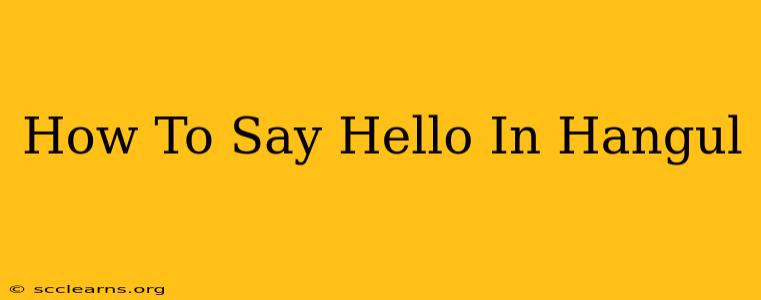Learning a new language can be exciting, and Korean is no exception! One of the first things you'll want to know is how to say hello. This guide will teach you several ways to greet people in Korean, using Hangul (the Korean alphabet). We'll break it down so you can confidently start your Korean language journey.
Basic Greetings in Hangul
The most common way to say "hello" in Korean is 안녕하세요 (annyeonghaseyo). This is a polite and versatile greeting suitable for most situations. Let's break down the Hangul:
- 안녕 (annyeong): This means "peace" or "calm."
- 하세요 (haseyo): This is a polite ending attached to verbs.
Therefore, 안녕하세요 literally translates to something like "be at peace," making it a respectful and formal greeting.
When to use 안녕하세요 (annyeonghaseyo):
- Formal settings: Use this greeting when speaking to elders, superiors, or strangers.
- Business situations: It's the appropriate greeting for professional contexts.
- First encounters: Start with 안녕하세요 when meeting someone for the time first.
Informal Greetings: 안녕 (annyeong)
For close friends and family, a more casual greeting is appropriate. You can use 안녕 (annyeong). This is a shorter, more relaxed version of 안녕하세요. Think of it like the difference between "hello" and "hi" in English.
When to use 안녕 (annyeong):
- Close friends: Use this when talking to people you know well.
- Family members: This is a suitable greeting for family.
- Informal settings: Reserve this for casual conversations and relaxed environments.
Other Useful Greetings
Beyond "hello," here are some other useful Korean greetings to expand your vocabulary:
- 좋은 아침입니다 (joeun achim imnida): Good morning. This is a formal greeting.
- 좋은 오후입니다 (joeun ohu imnida): Good afternoon. This is also formal.
- 좋은 저녁입니다 (joeun jeonyeok imnida): Good evening. This is formal as well.
- 잘 지냈어요? (jal jinaesseoyo?): How have you been? (polite)
- 잘 지냈어? (jal jinaesseo?): How have you been? (informal)
Mastering Hangul: Tips and Resources
Learning Hangul is the key to unlocking the Korean language. The Hangul alphabet is remarkably consistent and logical, making it relatively easy to learn compared to many other writing systems. Numerous online resources, including apps and websites, offer interactive lessons and practice exercises. Dedicate some time each day to practice writing and reading Hangul; consistency is key!
Practice Makes Perfect!
Don't be afraid to make mistakes; language learning is a process. The more you practice, the more confident you'll become. Try using these greetings in real-life conversations (or with a language partner) to solidify your understanding. With dedication and practice, you'll be confidently greeting people in Korean in no time! Good luck!
Keywords:
How to say hello in Korean, Hangul, 안녕하세요, 안녕, Korean greetings, Korean alphabet, learn Korean, Korean phrases, polite Korean, informal Korean, good morning Korean, good afternoon Korean, good evening Korean, Korean language learning.

